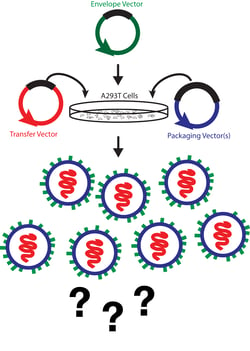An estimated 320,000 viruses can infect mammals. Even more abundant are the Earth’s estimated 1031 bacteriophages (viruses that infect bacteria), many of which are doing important work in our microbiomes. Given that viruses are everywhere and doing everything, it can be annoying when we try to use them in an experiment and they don't do anything.
Viruses are complicated and they perform complex biological tasks, both of which are factors in the technical challenges they can present. Many researchers find themselves plagued by troubleshooting a virus-based experiment at one point or another. After amplifying a viral vector, collecting virus, and transducing target cells, one may have the unfortunate experience of witnessing…nothing. For some unclear reason, cells are not getting transduced. Here, I will share five hail Marys that have helped me troubleshoot some technical obstacles when working with virus:
1. Viral vectors undergo DNA rearrangements.
![]() Depending on the composition of the viral vector and the repeat sequences present in the LTR, the vector may undergo genomic rearrangements during replication. To avoid genomic rearrangements, try amplifying the viral vector with bacteria designed to minimize rearrangements such as NEB Stable or use a standard strain, like DH5α, grown at 30 °C instead of 37 °C. If you’re unsure about the integrity of your virus, perform a diagnostic restriction enzyme digest and compare it to some reliable controls.
Depending on the composition of the viral vector and the repeat sequences present in the LTR, the vector may undergo genomic rearrangements during replication. To avoid genomic rearrangements, try amplifying the viral vector with bacteria designed to minimize rearrangements such as NEB Stable or use a standard strain, like DH5α, grown at 30 °C instead of 37 °C. If you’re unsure about the integrity of your virus, perform a diagnostic restriction enzyme digest and compare it to some reliable controls.
2. Viral stocks may be sensitive to freeze thaw cycles.
 Depending on the researcher and the type of virus, there have been varied reports of titer losses from 5% to 50% per freeze thaw cycle (Krajden et al., 1999; Ugai et al., 2002). If the virus will be used in a couple of days, some researchers prefer to store freshly harvested virus at 4 °C instead of storing it briefly at -80 °C. If troubleshooting, the safest option may be to avoid freezing altogether, and instead to use the virus immediately upon harvesting. Interestingly, freeze-thawing host cells immediately prior to their transduction has been shown to increase AAV transduction efficiency by approximately 15-fold (Chen et al., 2006).
Depending on the researcher and the type of virus, there have been varied reports of titer losses from 5% to 50% per freeze thaw cycle (Krajden et al., 1999; Ugai et al., 2002). If the virus will be used in a couple of days, some researchers prefer to store freshly harvested virus at 4 °C instead of storing it briefly at -80 °C. If troubleshooting, the safest option may be to avoid freezing altogether, and instead to use the virus immediately upon harvesting. Interestingly, freeze-thawing host cells immediately prior to their transduction has been shown to increase AAV transduction efficiency by approximately 15-fold (Chen et al., 2006).
3. Transduction efficiency depends on viral titer
 Both of these can be increased by concentrating a viral stock. Different titering methods can reveal differences in physical versus functional titer. If you have low titers (which is unavoidable for some vectors) you can concentrate your virus by ultracentrifugation of the viral stock, followed by resuspension of the collected particles in a smaller volume. Always remove packaging cell debris before proceeding to ultracentrifugation to avoid contaminating your transduction with the packaging cells. Packaging cell debris can be removed either by filtration of the virus solution (through a 0.45 µm or 0.22 µm filter) or by a centrifugation step (5 minutes at 300-500 g). After removing packaging cell debris, virus can be pelleted by ultracentrifugation (75,000 - 225,000 g for 1.5 – 4 hours at 4 °C). After ultracentrifugation, virus may appear as a white pellet. The pellet can then be rinsed and resuspended in cold sterile PBS.
Both of these can be increased by concentrating a viral stock. Different titering methods can reveal differences in physical versus functional titer. If you have low titers (which is unavoidable for some vectors) you can concentrate your virus by ultracentrifugation of the viral stock, followed by resuspension of the collected particles in a smaller volume. Always remove packaging cell debris before proceeding to ultracentrifugation to avoid contaminating your transduction with the packaging cells. Packaging cell debris can be removed either by filtration of the virus solution (through a 0.45 µm or 0.22 µm filter) or by a centrifugation step (5 minutes at 300-500 g). After removing packaging cell debris, virus can be pelleted by ultracentrifugation (75,000 - 225,000 g for 1.5 – 4 hours at 4 °C). After ultracentrifugation, virus may appear as a white pellet. The pellet can then be rinsed and resuspended in cold sterile PBS.
Alternatively, to concentrate a virus solution without ultracentrifugation, you can reduce the volume of cell culture medium on the packaging cells immediately following transfection. In other words, when exchanging the medium after transfecting cells, replace the medium with half the volume typically used (e.g., use 5 mL medium on a 10 cm plate). By reducing the culture volume into which the virus is released, a more concentrated virus solution can be obtained.
4. Enhancing virus-cell contact
A variety of reagents can increase transduction efficiency. These reagents typically enhance the adsorption of a virus particle to a target cell by reducing the repulsive electrostatic forces between these two negatively-charged membranes (Davis et al., 2002). Polybrene is one such cationic reagent that is commonly used and has been shown to increase transduction efficiency by 10-fold (Davis et al., 2002). However, polybrene is highly sensitive to freeze-thaw cycles and should be stored in single-use aliquots. Never use a polybrene solution that has been thawed more than once. Fibronectin is another membrane-interacting protein that can be used to enhance transduction efficiency in cells that are sensitive to the toxicity of polybrene (e.g., hematopoietic or primary cells), and has been shown to increase transduction efficiency by 1.5-fold (Stockschläder et al., 1999).
5. Check your packaging cells for infection
If your transductions aren’t working, you can check if virus is being generated by your transfected packaging cells. This check can be performed routinely and without disrupting the flow of your experiment. If your packaging cells have been successfully transfected and produced infectious virus, they may get infected with this virus, and therefore, will be selectable with the antibiotic whose resistance gene is encoded in the viral vector. This antibiotic selection can be performed approximately 72 hours after transfection and should give rise to a surviving population of approximately 20–50% of the packaging cells after 1–3 days of selection. A lower percentage of surviving cells may be the result of plasmid integration via recombination during transfection, and does not necessarily indicate the production of virus. Alternatively, if the virus encodes a fluorescent protein, the packaging cells could be examined with a microscope and should appear fluorescent if they were infected. While there may be some low-level fluorescent protein or resistance marker expression following transfection, higher-level expression after approximately 72 hours is likely the result of successful viral transduction. This method may not work if the virus does not have the proper tropism to infect the packaging cells. Another method of ensuring viral production is to perform PCR against components of the viral vector using the harvested viral solution as a PCR template.
Regardless of the type of virus you’re working with, there’s a lot that goes into virus design, production, and transduction. Once you’ve harvested, it’s generally a good idea to titer your virus. Getting an accurate count of the number of infectious particles in a given viral stock will give you a sense of the infectivity of your viral stock, save you time, and allow you to standardize your experiments later. Stay tuned to the Addgene blog and be sure to check out our viral vector guide pages to get up-to-date tips for your virus experiments.
References
1. Anthony, Simon J., et al. "A strategy to estimate unknown viral diversity in mammals." MBio 4.5 (2013): e00598-13. PubMed PMID: 24003179. PubMed Central PMCID: PMC3760253.
2. Rohwer, Forest. "Global phage diversity." Cell 113.2 (2003): 141. PubMed PMID: 12705861.
3. Chen, Sifeng, et al. "Freeze-thaw increases adeno-associated virus transduction of cells." American Journal of Physiology-Cell Physiology 291.2 (2006): C386-C392. PubMed PMID: 16510845.
4. Krajden, Mel, et al. "Effect of multiple freeze-thaw cycles on hepatitis B virus DNA and hepatitis C virus RNA quantification as measured with branched-DNA technology." Journal of clinical microbiology 37.6 (1999): 1683-1686. PubMed PMID: 10325307. PubMed Central PMCID: PMC84922.
5. Ugai, Hideyo, et al. "Stability of a recombinant adenoviral vector: optimization of conditions for storage, transport and delivery." Japanese journal of cancer research 93.5 (2002): 598-603. PubMed PMID: 12036457.
6. Davis, Howard E., Jeffrey R. Morgan, and Martin L. Yarmush. "Polybrene increases retrovirus gene transfer efficiency by enhancing receptor-independent virus adsorption on target cell membranes." Biophysical chemistry 97.2 (2002): 159-172. PubMed PMID: 12050007.
7. Stockschläder, M., et al. "Expansion and fibronectin-enhanced retroviral transduction of primary human T lymphocytes for adoptive immunotherapy." Acute Leukemias VIII. Springer Berlin Heidelberg, 2001. 291-306. PubMed PMID: 10634178.
8. Murnane, John P., Michael J. Yezzi, and Barbara R. Young. "Recombination events during integration of transfected DNA into normal human cells."Nucleic acids research 18.9 (1990): 2733-2738. PubMed PMID: 2339059. PubMed Central PMCID: PMC330758.
Additional Resources on the Addgene Blog
- Learn All about Adenovirus Associated Virus
- New to Virus? Check out Our Primer for Beginners!
- Learn All about Lentiviral Vectors
Additional Resources on the Addgene.org
- Check out Our Viral Vector Guide Pages
- Find Virus Protocols
- Order Virus






Leave a Comment